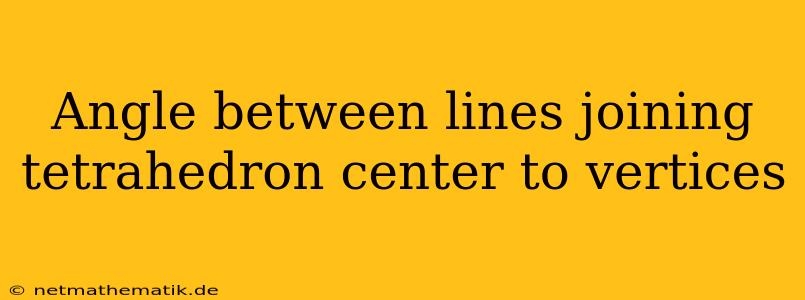The determination of the angle between lines joining the center of a tetrahedron to its vertices is a problem that arises in various fields, including geometry, crystallography, and molecular modeling. Understanding this angle provides insights into the spatial arrangement of the tetrahedron's vertices and its symmetry properties. This article explores the calculation and significance of this angle, delving into the geometric relationships within a tetrahedron and the tools used to analyze them.
Understanding the Geometry of a Tetrahedron
A tetrahedron, a four-sided polyhedron, is a fundamental shape in three-dimensional geometry. Its four faces are triangles, and its four vertices connect to form six edges. The center of a tetrahedron, also known as the centroid, is the point where the medians of each face intersect. These medians are lines drawn from a vertex of a triangle to the midpoint of the opposite side.
The Special Case of the Regular Tetrahedron
The most symmetrical type of tetrahedron is the regular tetrahedron, where all four faces are equilateral triangles, and all edges are of equal length. In this case, the centroid coincides with the circumcenter, the center of the sphere that circumscribes the tetrahedron, and also with the incenter, the center of the sphere that is inscribed within the tetrahedron.
Calculating the Angle between Lines Joining the Center to Vertices
To calculate the angle between the lines connecting the center of a tetrahedron to its vertices, we can utilize vector methods and the concept of the dot product. Let's consider a regular tetrahedron with vertices A, B, C, and D, and let O represent its center.
-
Vector Representation: Assign vectors to each vertex relative to the center O: OA, OB, OC, and OD.
-
Dot Product: The dot product of two vectors is defined as the product of their magnitudes multiplied by the cosine of the angle between them. Therefore, the cosine of the angle between OA and OB can be calculated as:
cos(θ) = (OA · OB) / (||OA|| ||OB||)
-
Geometric Considerations: Due to the symmetry of a regular tetrahedron, the magnitudes of all the vectors from O to the vertices are equal. This means: ||OA|| = ||OB|| = ||OC|| = ||OD||.
-
Angle Calculation: Substituting this into the dot product equation, we can simplify the expression for the cosine of the angle to:
cos(θ) = (OA · OB) / (||OA||^2)
-
Finding the Dot Product: To determine the dot product, we need to express the vectors OA and OB in terms of their Cartesian components. Using the symmetry of the tetrahedron and the fact that the centroid divides each median in a 2:1 ratio, we can find the coordinates of the vertices relative to the center.
-
Substituting Coordinates: Once we have the vector components, we can substitute them into the dot product equation and obtain the value of cos(θ). Finally, we can use the inverse cosine function to find the angle θ.
Significance of the Angle
The angle between lines joining the tetrahedron center to its vertices has various applications, including:
-
Molecular Structure: In chemistry, tetrahedral geometry is common for molecules like methane (CH4). The angle between the C-H bonds determines the molecule's shape and influences its chemical properties.
-
Crystallography: Crystals often exhibit tetrahedral symmetry. Understanding the angles between vertices helps in analyzing crystal structures and predicting their optical and mechanical properties.
-
Engineering: The tetrahedral shape is employed in various engineering structures due to its inherent stability. The angles between vertices are crucial in optimizing the load distribution and structural integrity.
Conclusion
The calculation of the angle between lines joining the center of a tetrahedron to its vertices involves understanding the geometric properties of the shape and utilizing vector methods. This angle holds significance in various fields, including chemistry, crystallography, and engineering, where it influences molecular properties, crystal structures, and structural stability. By analyzing these angles, we gain valuable insights into the spatial arrangement and symmetry of tetrahedral structures, which are fundamental building blocks in the three-dimensional world.
